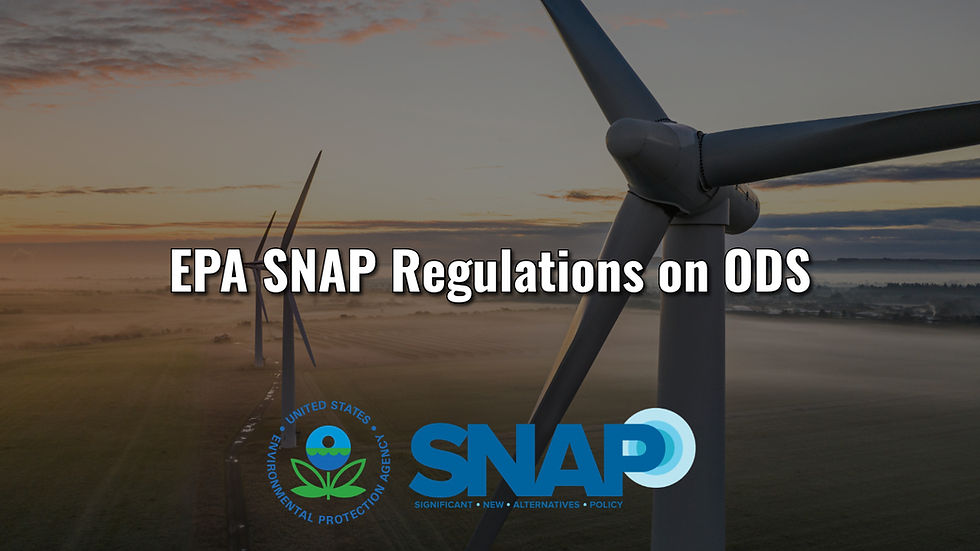HFC Compounds Regulated by Aim Act
- donaldarrington
- Oct 4, 2024
- 3 min read
Updated: Mar 23

Understanding HFCs and Regulations
Hydrofluorocarbons, commonly referred to as HFCs, are a class of chemicals useful in many industrial applications. These chemicals are employed as propellants in aerosol products, as refrigerants in air-conditioning systems and refrigeration systems, and as solvents in many manufacturing processes. The use of HFCs became widespread in industry toward the end of the 20th century for the purpose of replacing ozone-depleting substances such as chlorofluorocarbons, or CFCs, and hydrochlorofluorocarbons, known as HCFCs.
Regulated HFC's by AIM ACT
Chemical Name | Common Name | Exchange Value* |
CHF2 CHF2 | HFC–134 | 1,100 |
CH2 FCF3 | HFC–134a | 1,430 |
CH2 FCHF2 | HFC–143 | 353 |
CHF2 CH2 CF3 | HFC–245fa | 1,030 |
CF3 CH2 CF2 CH3 | HFC–365mfc | 794 |
CF3 CHFCF3 | HFC–227ea | 3,220 |
CH2 FCF2 CF3 | HFC–236cb | 1,340 |
CHF2 CHFCF3 | HFC–236ea | 1,370 |
CF3 CH2 CF3 | HFC–236fa | 9,810 |
CH2 FCF2 CHF2 | HFC–245ca | 693 |
CF3 CHFCHFCF2 CF3 | HFC–43–10mee | 1,640 |
CH2 F2 | HFC–32 | 675 |
CHF2 CF3 | HFC–125 | 3,500 |
CH3 CF3 | HFC–143a | 4,470 |
CH3 F | HFC–41 | 92 |
CH2 FCH2 F | HFC–152 | 53 |
CH3 CHF2 | HFC–152a | 124 |
CHF3 | HFC–23 | 14,800 |
HFCs fall into a class of compounds consisting of hydrogen, fluorine, and carbon atoms. Because there are vast differences in the chemical structure within the family of HFCs, each maintains a different application depending on the variety of properties desired. For example, there is HFC-134a, which is primarily used in automotive air conditioning, while HFC-227ea is mainly utilized as a fire suppressant and a propellant. These products offered an outstanding blend of stability, non-toxicity, and effectiveness that for many years favored their use in various fields.
But that stability which ultimately makes HFCs useful extends to environmental concerns. While naturally occurring compounds break down rather rapidly in the atmosphere, HFCs can persist for decades, even centuries, trapping heat and playing their part within the greenhouse effect. As climate change awareness grows, so does the call for sustainable alternatives.
The Push for Regulation and the Shift to HFOs
Consequent upon the fact that these gases contribute to global warming, their use has been phased out under international agreements such as the Kigali Amendment to the Montreal Protocol, which calls for the gradual reduction of HFC production and consumption. Such regulations accelerated the development and adoption of hydrofluoro-olefins as environmentally friendlier alternatives.
HFOs will represent a new class of fluorinated gases that can boast similar beneficial properties to HFCs, with one key advantage: very low GWP, thus being far less harmful for the environment. For example, while the GWP of HFC-134a is 1,430, that of HFO-1234yf-one of the commonly used alternatives-is below 1. Such a drastic reduction of the global warming effect renders HFOs an ecological solution for those industries which cannot do without refrigerants and propellants.
Why Switch To HFO Chemistry Powered By Yuji
HFOs provide clear environmental benefits, but for many companies, switching from HFCs to HFOs is a technologically tricky transition. Even though the chemical properties of HFOs are very similar to those of HFCs, some adjustment has to be made by existing systems and technologies to work. Compatibility with today's refrigeration system, handling safety, and performance optimization have turned this transition into something more complex than the simple chemical swap that it otherwise could have been.
This is where companies like Yuji come in to support the customers through the regulatory landscape and technical challenges associated with the adoption of HFOs. The core competencies of Yuji range from supporting clients through the changing regulations to the R&D capabilities required in overcoming such technical challenges. Whether it is in the development of mechanisms to ensure new refrigerants work seamlessly in existing systems or continuous development of solutions to maintain efficiency, Yuji provides critical supports through which industries can transition into the sustainable alternative with ease.
The phasing out of HFCs and rise of HFOs mark significant changes in how industries approach the use of refrigerants, propellants, and solvents.
HFCs were no more than a stopgap solution for the depletion of the ozone layer, while their very high GWP has made them incompatible with the threat of climate change. The low GWP of HFOs makes them a promising alternative, and companies like us at Yuji are at the forefront of answers regarding the feasibility of such a transition driven by both regulatory and technical needs. This shift towards environmentally benign chemicals will thus be vital in the minimization of global warming as industries move to meet these new demands.




Comments